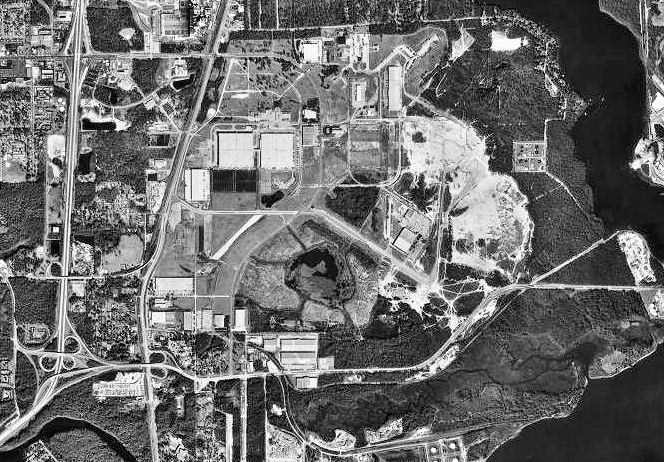- Imeson Field
Infobox Airport
name = Imeson Field

image-width = 300
caption = Remains of Imeson Field, 22 January 1994. Old runways and hangars are still visible in photo.
IATA =
ICAO =
FAA =
type =
owner =
location =Jacksonville, Florida
elevation-f = 20
elevation-m = 6.1
coordinates = coord|30|25|12|N|081|38|24|W|type:airport_region:USImeson Field, aka Jacksonville Imeson Airport, was the original airport serving
Jacksonville, Florida , being established in 1927, and closing in 1967. Over the years it was known as Jacksonville Municipal Airport, prior toWorld War II , and Jacksonville Army Airfield when theUnited States Army Air Forces controlled the facility duringWorld War II .Origins
Imeson Field was built southeast of the intersection of North Main Street and Busch Drive, the site of a 175 acre prison farm located north of downtown Jacksonville. When opened in 1927, it had a 2,100' cinder and shell runway, a 2,500' grass runway, an administration building and a hangar. In its first year, the new airport was visited by
Charles Lindbergh . By 1934, the Department of Commerce Airport Directory described Jacksonville Airport as having four "sandy, sodded, surfaced" runways, all 2,500' long, with a row of hangars on the side of the airfield. The manager was listed as Major H. A. Maloney.By 1941, the airport had expanded to 600 acres, acquiring five additional hangars and a terminal building, and five asphalt runways, the longest of which was 7,000 feet. Airline service was provided by
Eastern Airlines ,Orlando Airlines , andNational Airlines , which made Jacksonville its headquarters.World War II
With the start of
World War II , the USAAF began to use Jacksonville for antisubmarine missions in 1941. Later, the airfield was turned over to the United States Navy, and by 1945, Naval Auxiliary Air Station Jacksonville began to use the improved PB4Y-2 Privateer (B-24). The base's maximum aircraft complement was reached in 1945, with a total of 67 aircraft assigned.Postwar Use
After the end of World War II, the Navy returned the field to the City of Jacksonville, which reopened the field as a civil airport named Jacksonville Imeson Airport, named after Thomas Cole Imeson. Imeson, who died in 1948, was a long time city councilman whose visionary work led to the opening of the airport in the 1920s.
It flourished during the 1950s. With the introduction of jet airliners in the early 1960s, however, the geographic limitations which precluded lengthening of the runways became a fatal liability.
The new
Jacksonville International Airport was opened to the north in 1967, and aircraft operations at Imeson Field ended in 1968.Imeson Industrial Park
In 1970, Webb International Inc. purchased the former 1,500-acre airport and then proceeded to turn it into a new commerce center, Imeson International Industrial Park, with numerous buildings being constructed over the former runways.
The remaining southeastern portion of Runway 30 has been reused as Imeson Park Boulevard.
See also
*
Florida World War II Army Airfields References
* [http://www.airfields-freeman.com/FL/Airfields_FL_Jax_NE.htm]
* [http://www.metrojacksonville.com/content/view/253/68/]External links
* [http://members.tripod.com/airfields_freeman/FL/Airfields_FL_Jax_NE.htm Abandoned & Little-Known Airfields: Florida: Northeastern Jacksonville area Jacksonville Municipal Airport / Jacksonville Army Airfield / Imeson Field]
Wikimedia Foundation. 2010.
